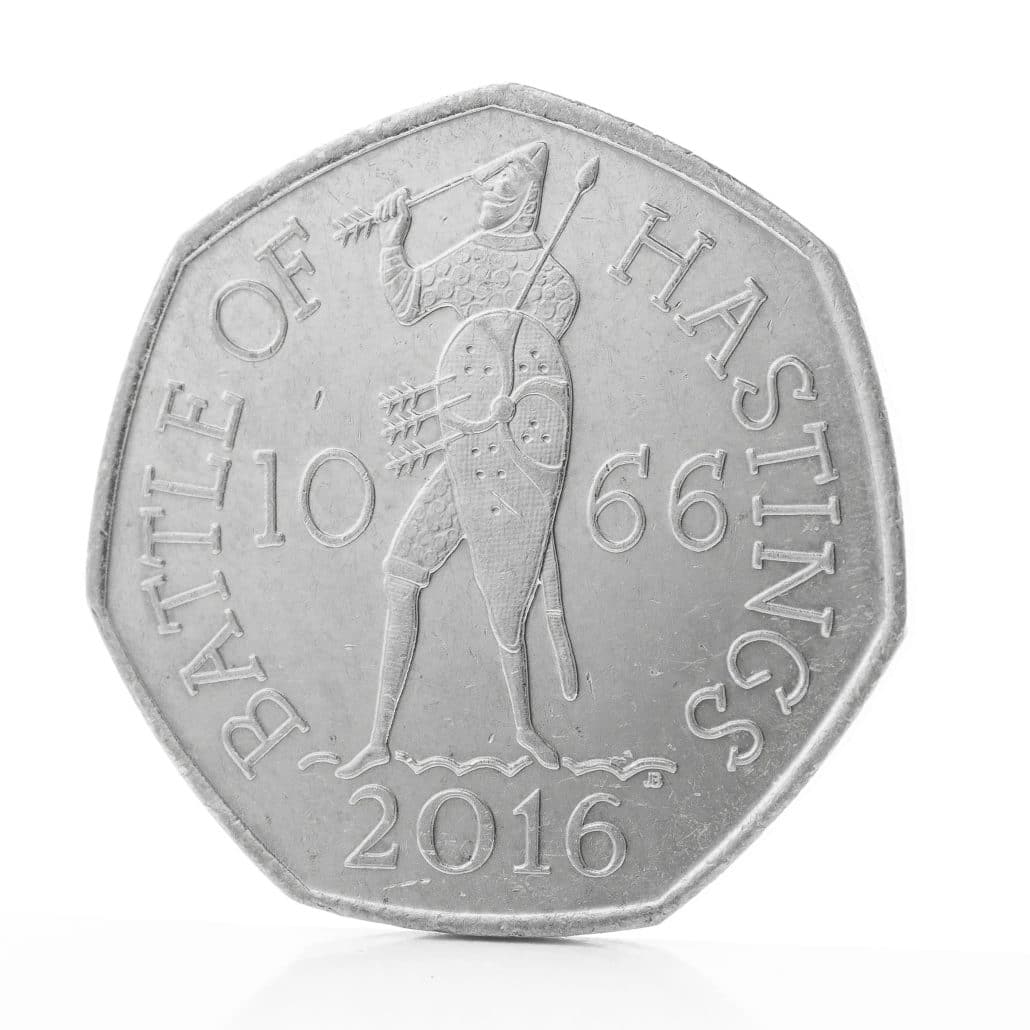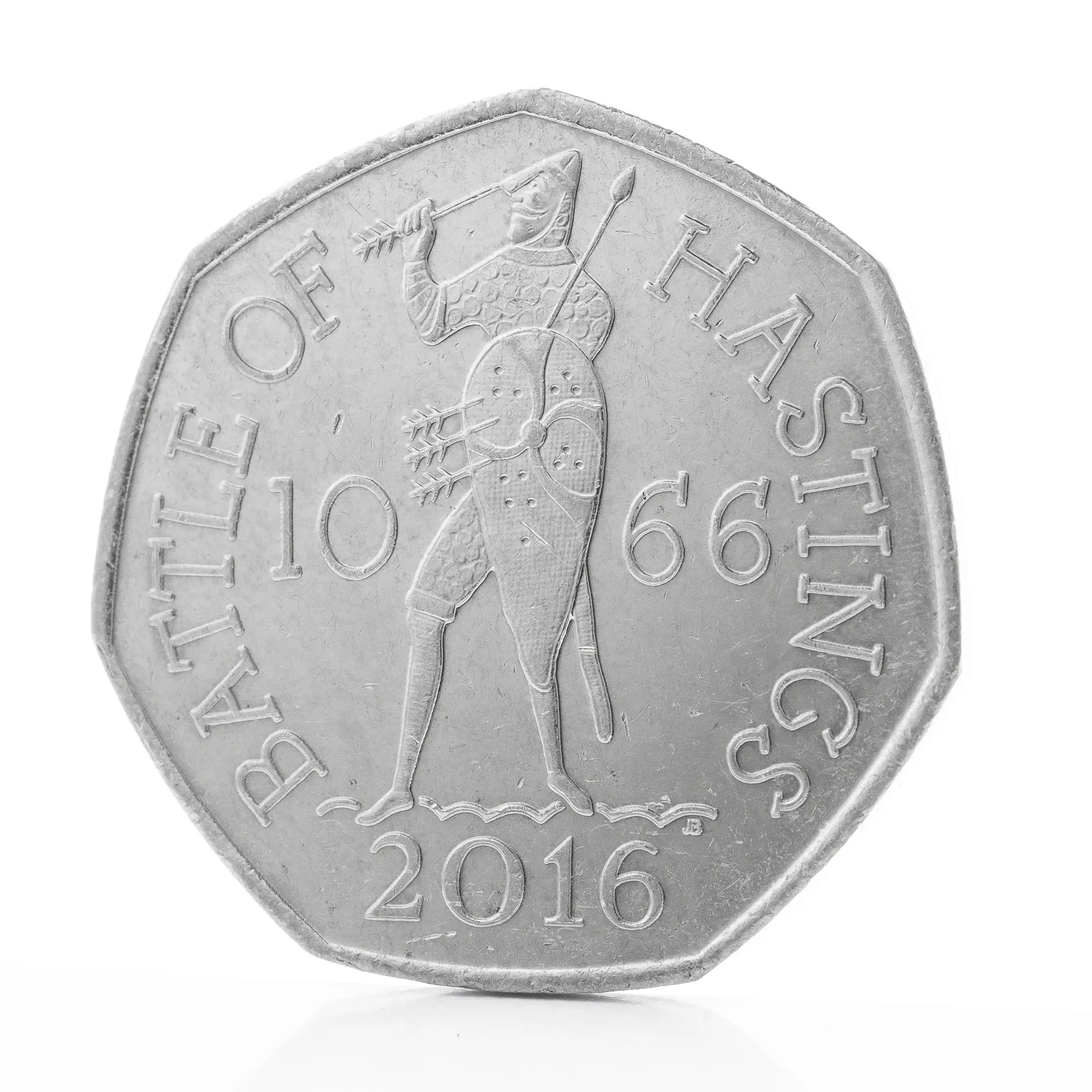Since writing this article last year, the price of the Battle of Hastings 50p has changed significantly. Since the infamous eBay sale of £63,100.00 last year, the prices were heavily inflated for a while but that seems to have settled down now. As such, we’ve updated the average values accordingly.
According to the most recent eBay confirmed sold prices, the Battle of Hastings 50p sells for an average of £1.60 in circulated condition not including postage and packaging in 2021.
The value of the coin depends on whether it is in circulated or uncirculated condition, and can vary greatly between each sale. You can take the above price as a guide towards what the aver value is
The thing to consider here is that the coin is not particularly rare and that on eBay it seems there are a lot of buyers who are not informed correctly.
The choice to buy or sell this coin is entirely up to you, but we hope we can provide a bit of clarity in this article.
The Battle of Hastings 50p Design and Background
The Battle of Hastings 50p coin design features the Death of King Harold during the Battle of Hastings on the 14th October 1066. The design was created by John Bergdahl and is influenced by the Bayeux Tapestry, an embroidered cloth that depicts the events of the battle. The inscription 1066 is in tribute to the year the battle took place, with the words ‘BATTLE OF HASTINGS’ around the outside.
The Battle of Hastings was fought between the English army led by King Harold Godwinson and the Norman-French Army led by William, Duke of Normandy; and marked the beginning of the Norman conquest of England.

Harold had been under pressure after becoming King from his own brother Tostig and the Norwegian King Harald Hardrada, due to the previous King – Edward the Confessor – not having any children to take the throne after him.
The Battles of Fulford and Stamford Bridge in September 1066 had significantly weakened Harold’s Army, and meant that William was the only opposition to the throne as Tostig and Hardrada were killed during the Battle of Stamford Bridge.
Whilst King Harold’s Army was still recovering, William landed in Pevensey on the 28th of September 1066. The Battle itself was a swift victory for the Normans and marked the beginning of the Norman Conquest of England.
Is the Battle of Hastings 50p rare?
Minted in 2016, the Battle of Hastings 50p represents the 950th Anniversary of the Battle of Hastings. This is a circulating coin, and can hence be found in your change. But how rare is the coin?
The mintage figure for the Battle of Hastings 50p stands at 6,700,000. Generally speaking, this does not make the coin very rare. To give you some context, in order to get into the top 5 rarest 50p coins, a 50p would need to have a mintage of less than 1,801,500 (excluding the Olympic coins).
It can be very difficult to estimate how many of these coins remain in circulation, as new 50p designs tend to be very collectable and therefore it is quite likely that a lot of them will have already been collected. Alongside being collected, some will have also been thrown away or discarded and so we will never be able to know exactly how many remain out there.
There are numerous examples of this coin being sold on eBay which further emphasizes how collectable these coins actually are. Should you come across one of these in your change, there is definitely a market out there to sell one.
Battle of Hastings 50p sells for £63,100 on eBay?
The main problem with buying and selling coins on eBay is that there is no regulation. People can list coins for whatever value they choose, regardless of whether the particular coin is rare or not. According to the listing shown below, a Battle of Hastings 50p sold for £63,100.00 on eBay on 15th June 2020.

So, we’ve already established that the coin is not actually worth a great deal. Most people would argue, in fact, that it is not worth any more than its face value of 50 pence.
So how exactly did this particular coin sell for £63,100.00?
The likelihood of this amount of money actually changing hands is practically zero. The likely explanation is that, whilst showing a completed sale on eBay, the money never got transferred. Following the supposed sale, many of the coins were listed at lower value – but still well above face value – and sold quickly as people were lead into thinking they got a bargain.
The moral of the story here is to make sure you take your time to research any coin before you decide to purchase one. You can quickly find yourself getting completely ripped off if you don’t.
